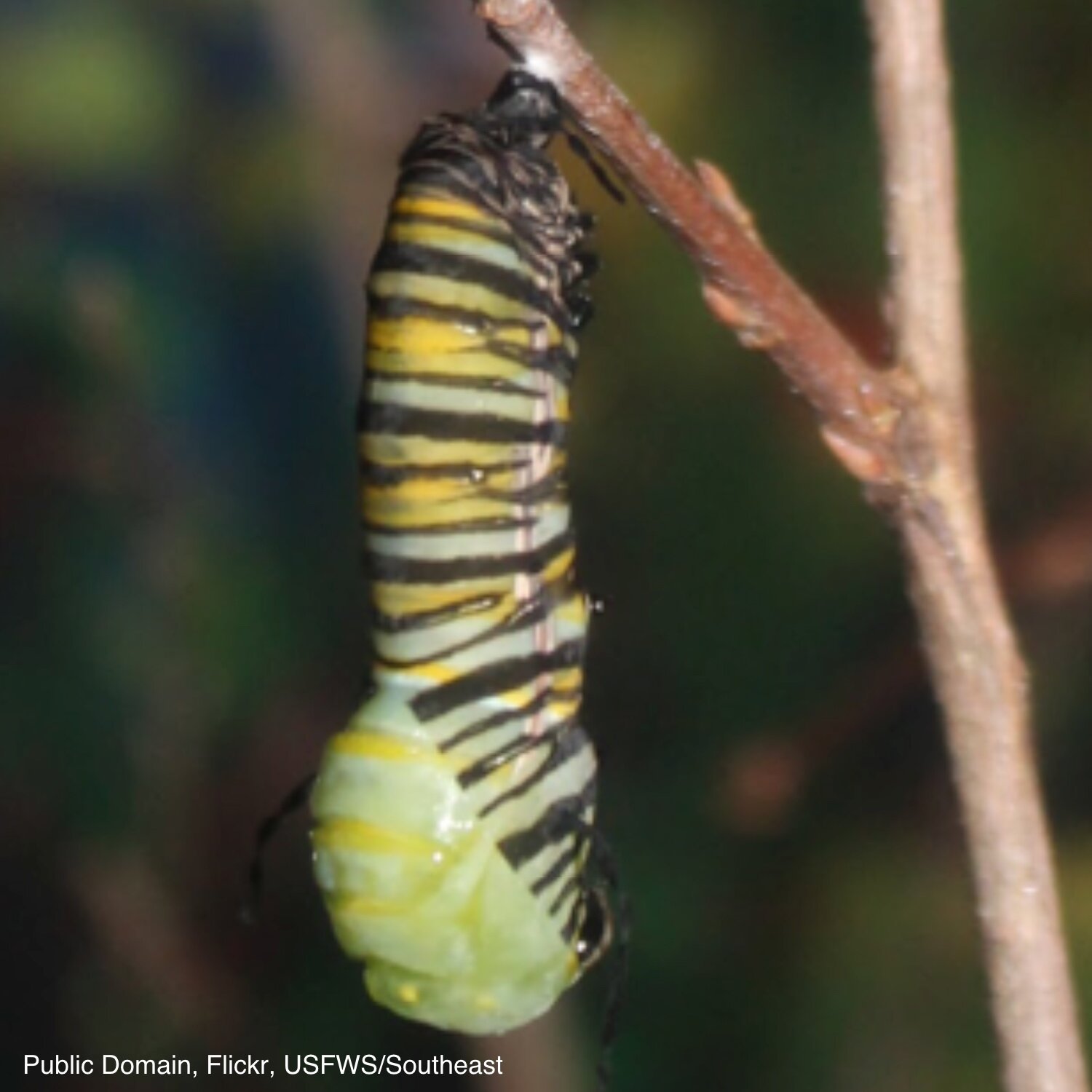| Raising monarchs | Eggs | Caterpillars | Chrysalis | Butterflies |
Raising kahuku/monarchs in New Zealand
The kahuku1/monarch butterfly (Danaus plexippus) is a popular insect to observe. The tiny ornate eggs hatch into conspicuous stripy caterpillars. After several weeks of relentless eating these change into a bright green pupa with golden details. Finally, a large colourful butterfly emerges.
Monarch caterpillars have very particular requirements for their food source. Otherwise they are generally easy to care for.
Monarch eggs
In New Zealand, female monarch butterflies mostly lay their eggs on swan plants2 (Gomphocarpus physocarpus, Figure 5). They are careful to select the correct plants since the caterpillars can only eat certain species.
If you are in an area where monarchs already live2 (Figure 6), all you need to start raising caterpillars is to get some swan plants and wait. The butterflies will seek them out to lay their eggs upon the leaves (Figure 7). The eggs are small, but visible.
It takes about a week for the egg to mature, with the time depending mainly on temperature3. When it is about to hatch, in a process known as eclosion, the caterpillar’s dark head is visible moving inside the egg4 (Figure 8).
Monarch caterpillars
The tiny caterpillars eat their way out of the eggshell and eats the rest of the egg. It then starts eating the swan plant leaf it is on.
The caterpillars are insatiable feeders, so a common problem is that too many eggs (and therefore caterpillars) are laid on each plant. The plants are unable to provide enough food for a large number of caterpillars to develop to maturity (Figure 9).
One way to avoid running out of food is to wait until just a few eggs are laid, then protect the plant from further butterfly visits. This can be done by surrounding the plant(s) with netting (Figure 10).
An observation cage is also a good place to raise some caterpillars. The cage prevents overcrowding and running out of food. It also excludes most parasites and predators.
A whole growing swan plant will not usually fit into the observations cage. Instead, place regular fresh swan plant cuttings in some water in the cage - though be sure to cover the water so that the caterpillars can’t fall into it.
The caterpillars eat until they reach a certain size, and then spin a silk pad to anchor themselves to. They hook some of their legs into the silk pad. There is a pause and then the skin splits and the next size of caterpillar emerges. The caterpillars usually eat their shed skin3.
This process repeats through 5 caterpillar stages, known as instars5.
At the end of the 5th instar the caterpillar is ready to form a chrysalis. It may wander for 2-3 hours to find somewhere suitable, with shelter plus space underneath for when the butterfly emerges3.
Here it spins a silk button and buries its end prolegs into the silk before letting go with all the other legs. Its body hangs in a j-formation for several days6 (Figure 12).
At the end of this it looks a bit faded and wrinkled, and it straightens out. The caterpillar skin splits and the chrysalis becomes visible (Figure 13). It wriggles so that the old skin gets pushed to the top.
As part of this change to chrysalis it inserts a ‘peg’ (called a cremaster) into the silk button. This enables it to stay suspended, even when the prolegs from the old skin are no longer attached3.
Monarch chrysalis/pupa
The newly-formed chrysalis (Figure 14) shrinks and hardens6 (Figure 15). The butterfly develops inside for several weeks.
When close to hatching the chrysalis looks milky, because of the air gap between the butterfly and the chrysalis cuticle. The colours of the butterfly become visible inside (Figure 16).
Monarch butterflies
When fully developed, the chrysalis splits and the butterfly emerges (Figure 17). It drops below the chrysalis, now called an exuvia7, and clings to it while its wings unfurl and harden (Figure 18).
Soon, it is ready to fly off (Figure 19). As a butterfly it will feed on liquid sugar from flowers.
Once they are ready to fly the butterflies should be released to resume their life cycle by finding a mate, and so that the females can lay more eggs (Figure 20).
They are a spectacular example of complete metamorphosis, with the remarkable change from egg, to caterpillar (larva), to chrysalis (pupa), to butterfly.
Related links:
| Raising monarchs | Eggs | Caterpillars | Chrysalis | Butterflies |
For some more resources on Aotearoa’s moths and butterflies, see the Moths and Butterflies of New Zealand Trust - Pūrerehua Aotearoa.
References
1. Māori Dictionary. https://maoridictionary.co.nz/.
2. Monarch (Danaus plexippus). iNaturalist NZ https://inaturalist.nz/taxa/48662-Danaus-plexippus.
3. Gibbs, G. W., Berndt, Lisa, Pawson, S., Gibbs, G. W., & Entomological Society of New Zealand. The monarch butterfly in New Zealand. (2013).
4. Treeclimber100. All of Nature: Monarch Butterfly Egg Hatching. All of Nature https://allofnature.blogspot.com/2013/06/monarch-butterfly-egg-hatching.html (2013).
5. Guide to Monarch Instars. The Monarch Joint Venture. https://monarchjointventure.org/monarch-biology/life-cycle/larva/guide-to-monarch-instars.
6. Moths and Butterflies of New Zealand Trust - Pūrerehua Aotearoa.
























